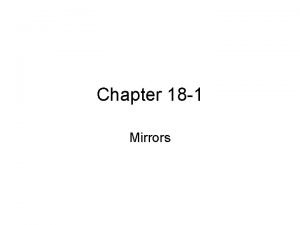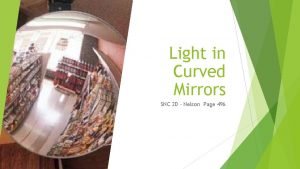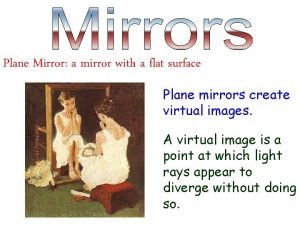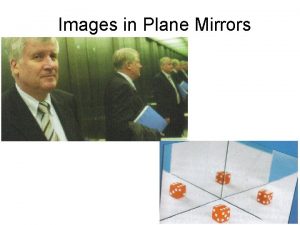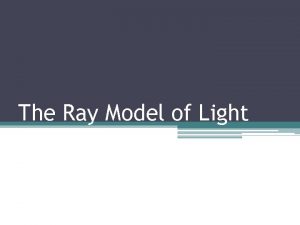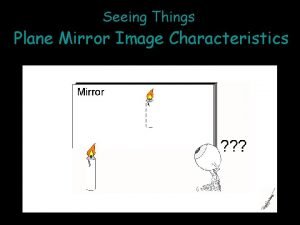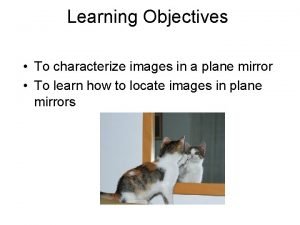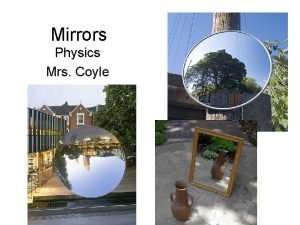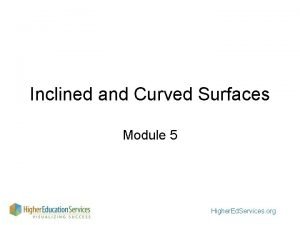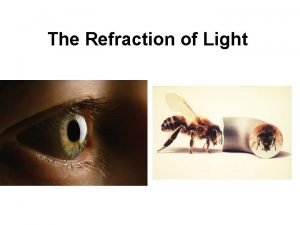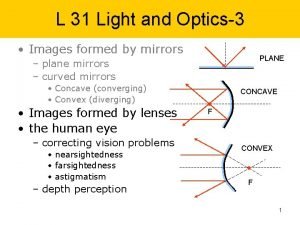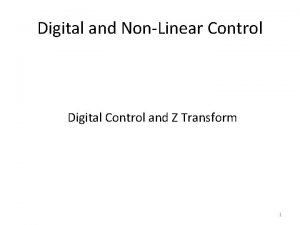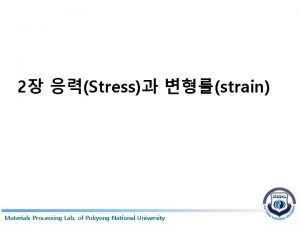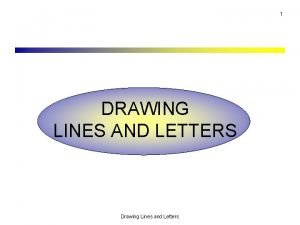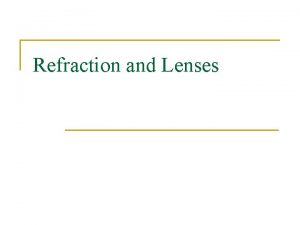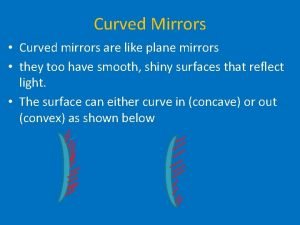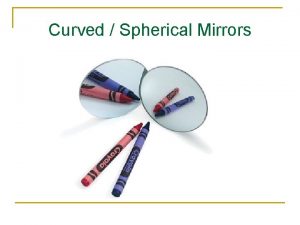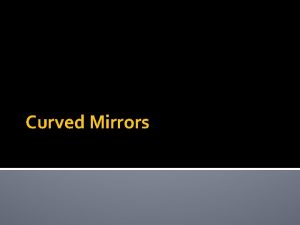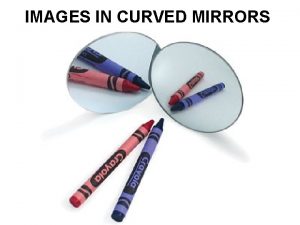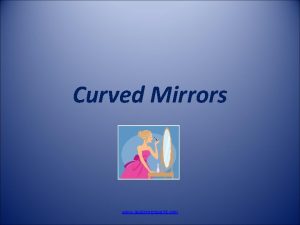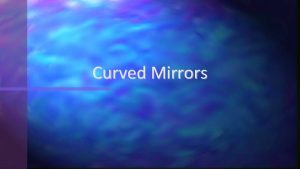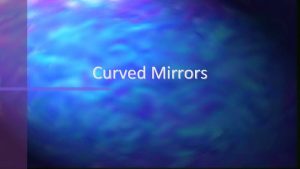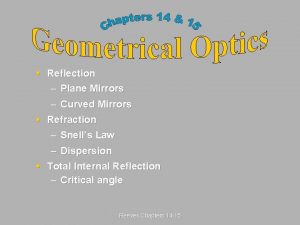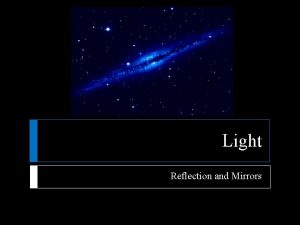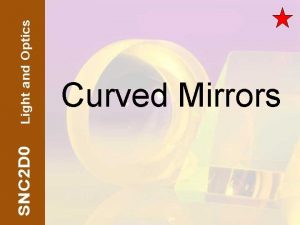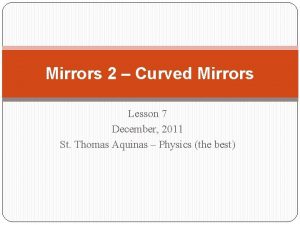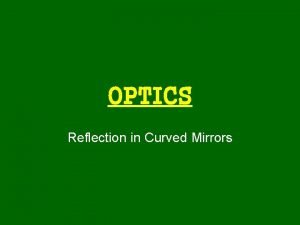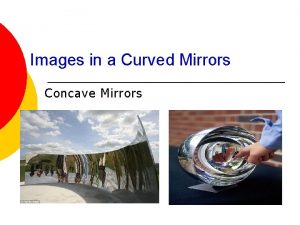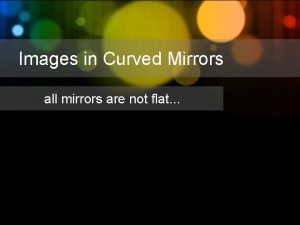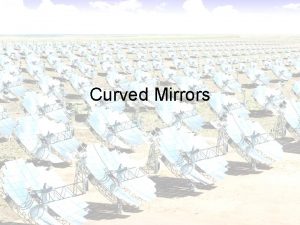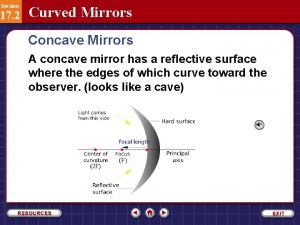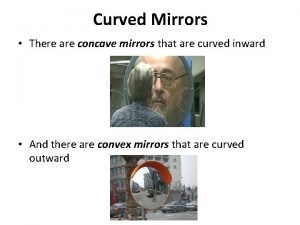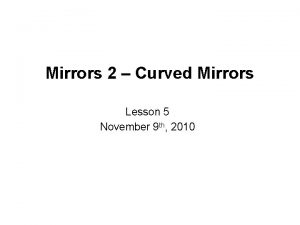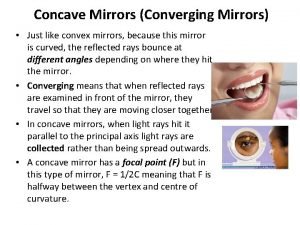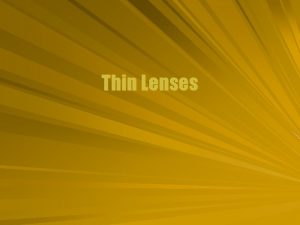Plane and Curved Mirrors Light is part of

























- Slides: 25

Plane and Curved Mirrors

Light is part of Electromagnetic Spectrum – the part we can see, i. e. the visible spectrum Shortest Longest Electromagnetic waves (including light) travel at a speed of 3 x 108 ms-1 (see notes for more information)

The visible spectrum is made up of seven colours. ROYGBIV – it is in reverse due to the wavelengths – shortest to longest • Can you explain why we can see these different colours. • Is black a colour? Light bounces of surfaces. Click the link below (must have Quicktime installed) to find more about bouncing light and ……. photons. http: //www. teachersdomain. org/asset/lsps 07_vid_lightreflect/

A ray of light is an extremely narrow beam of light.

All visible objects emit or reflect light rays in all directions.

Our eyes detect light rays.

We see images when light rays converge in our eyes.

Light can be reflected. Reflection is the bouncing of light of a solid object It is possible to see images in mirrors. image object

Mirrors are good at reflecting light rays.

Why Are Mirrors not White • A white object only appears white if white light is striking it. If only red light is striking it, it appears red. A mirror has less distortion than other surfaces so it reflects light in a straight line. You don't see the surface of the mirror but rather the objects from which the light originates. • It's important to remember that light itself has no colour. Colours are merely how our brains interpret different wavelengths.

Plane Mirrors How do we see images in mirrors? Light reflected off the mirror converges to form an image in the eye. image The eye perceives light rays as if they came from the mirror. The image is virtual since it is formed by the apparent intersection of light rays. (apparent rays are indicated on the diagram as broken lines and actually don’t exist)

Laws of Reflection Exp. - Follow steps in animation The normal is a line right angles to the mirror where the ray of light hits it. (A ray of light striking the mirror at 900 is reflected back along the same path). normal Law 1 When light is reflected off a mirror, it hits the mirror at the same angle (the incidence angle, θi) as it reflects off the mirror (the reflection angle, θr). Law 2 The incident ray, the reflected ray and the normal all lie on the same plane. Angle of reflection Angle of incidence reflected ray incident ray θr θi Mirror

Concave Mirror- Part of a sphere reflective surface on inside • C r • F f C: the center point of the sphere r: radius of curvature (just the radius of the sphere) F: the focal point of the mirror (halfway between C and the mirror) f: the focal distance, f = r/2

Concave Mirrors (caved in) • F optical axis • Light rays that come in parallel to the optical axis reflect through the focal point • Light rays that come in along the optical axis strike the mirror at 90 so reflect back along optical axis through the focal point.

Concave Mirror Image formed in a concave mirror object placed outside centre of curvature Centre of Curvature Focus v Object • c • F u f Principal axis Image: - Real, Inverted & diminished

Concave Mirror Image formed in a concave mirror when object placed at centre of curvature Centre of Curvature u. Focus Object • c f • F Principal axis v Image: - Real, Inverted & diminished

Concave Mirror Image formed in a concave mirror when object placed between centre of curvature & focus Centre of Curvature Focus u Object • c • F f Principal axis v Image: - Real, Inverted & Enlarged

Concave Mirror Image formed in a concave mirror when object placed at focus Centre of Curvature Focus Object • c • F u f Principal axis Image: - At Infinity

Concave Mirror Image formed in a concave mirror when object placed inside focus Centre of Curvature u Focus Object • c • F Principal axis f v Image: - Virtual, Erect & Enlarged

Equation ƒ = focal length u = object distance v = image distance if distance is negative the image is behind the mirror

Magnification Equation m = magnification v = image height u = object height if the magnification is negative the image is inverted (upside down)

Sign Convention for Mirrors Quantity Positive (+) Negative (--) Object location (u) Object is in front of Object is behind the mirror Image location (v) Image is front mirror Image is behind of mirror Focal length (f) Mirror is concave Mirror is convex Magnification (M) Image is upright Image is inverted

TO FIND THE FOCAL LENGTH OF A CONCAVE MIRROR Crosswire Concave mirror Lamp-box Screen u v Procedure • Get the approx. focal length of mirror by focusing distant object on screen – why? • Place the lamp-box well outside the approximate focal length – why? • Move the screen until a clear inverted image of the crosswire is obtained. • Measure the distance u from the crosswire to the mirror, using the metre stick. • Measure the distance v from the screen to the mirror. • Calculate the focal length of the mirror using - - - • • Repeat this procedure for different values of u. Calculate f each time and then find an average value.

Convex Mirrors • F optical axis Light rays that come in parallel to the optical axis reflect from the focal point. The focal point is considered virtual since sight lines, not light rays, go through it.

Convex Mirrors Focus Centre of Curvature v Object u f • F • C principal axis Image: - Virtual, Erect & Diminished
 It is a flat smooth mirror
It is a flat smooth mirror Curved mirrors
Curved mirrors Data plane control plane and management plane
Data plane control plane and management plane A mirror with a flat surface.
A mirror with a flat surface. Salt characteristics optics
Salt characteristics optics What has historically been the main use for plane mirrors
What has historically been the main use for plane mirrors Plane mirror salt
Plane mirror salt All images in plane mirrors are apex
All images in plane mirrors are apex Mirror in physics
Mirror in physics Curved inclined plane
Curved inclined plane Orthographic projection inclined surfaces
Orthographic projection inclined surfaces Light light light chapter 23
Light light light chapter 23 Into the light chapter 22
Into the light chapter 22 Chapter 22
Chapter 22 Rainbow total internal reflection
Rainbow total internal reflection Why does light not bend when it hits a curved surface
Why does light not bend when it hits a curved surface This leads the balance wheel through the belt connection
This leads the balance wheel through the belt connection Forwarding equivalence class
Forwarding equivalence class Inverse z-transform solved examples
Inverse z-transform solved examples 후크의 법칙
후크의 법칙 Lightly sketch the square and mark the midpoints
Lightly sketch the square and mark the midpoints Put out the light and put out the light
Put out the light and put out the light Leucoplast double membrane
Leucoplast double membrane The bouncing off of light.
The bouncing off of light. What is refraction in lenses
What is refraction in lenses Chapter 17 reflection and mirrors
Chapter 17 reflection and mirrors
